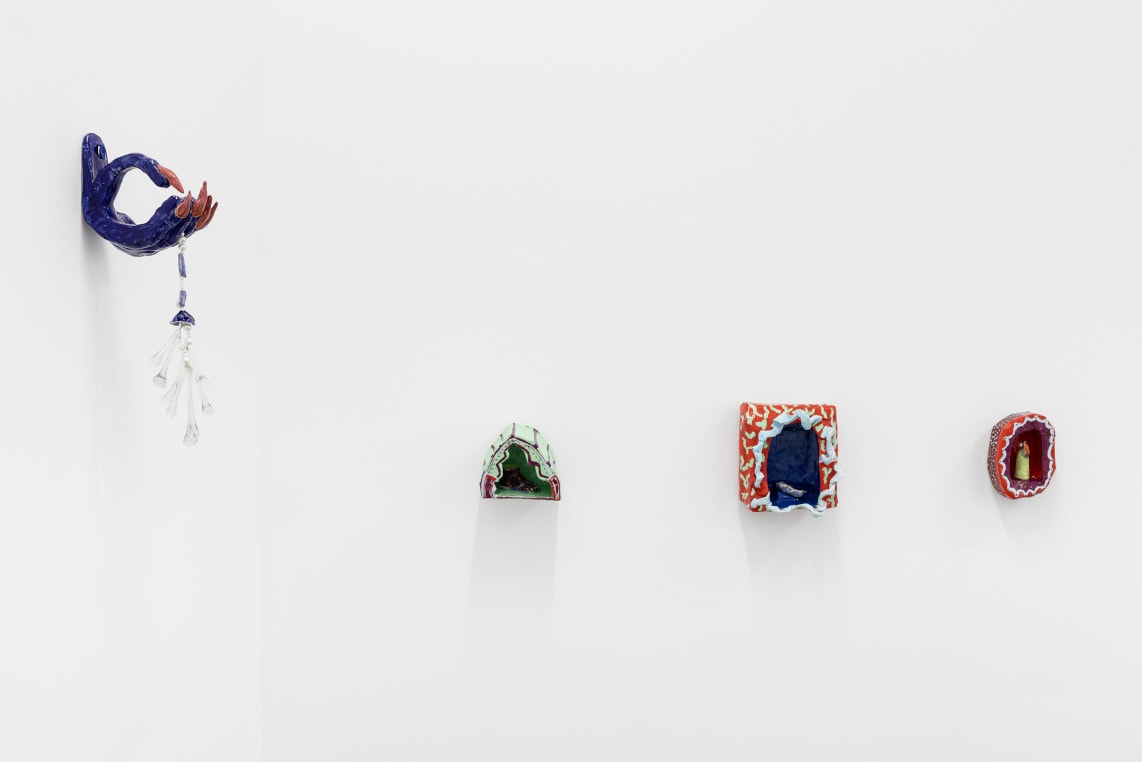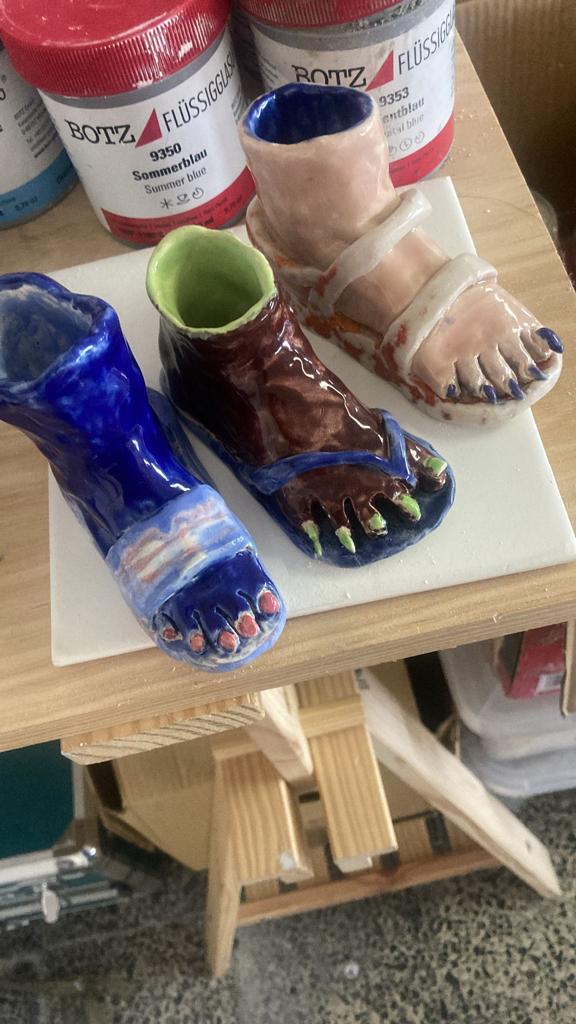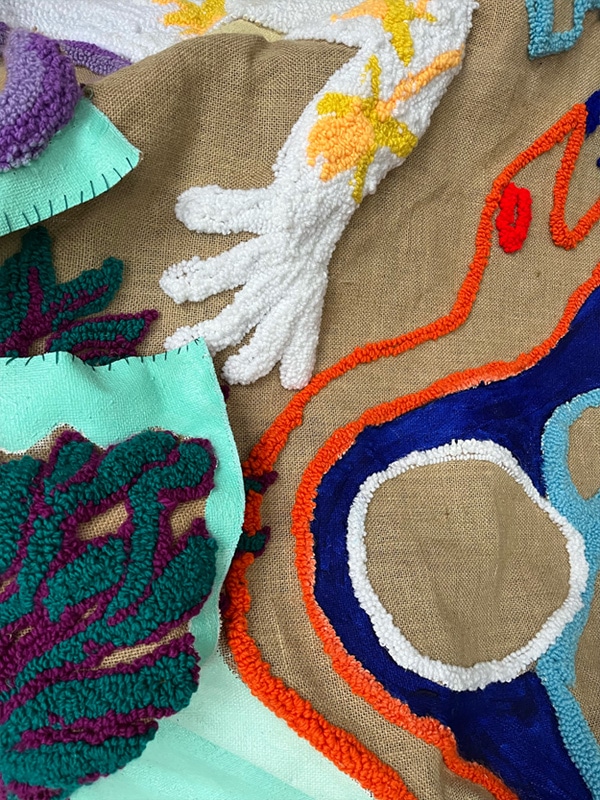WHAT DOES A MONSTER LOOK LIKE A BIKINI?
As ironic as it may sound, here you will find a morphed narrative where beasts are belle and the belle is a beast - a profound, critical and personal scenario. A seemingly spontaneous idea that led Lisette into manipulating ceramics again: molding, firing, painting and back to hands-on shaping, heating and staining… This story starts with delicate ceramic letters becoming dancing figurines, and then transforming into cheeky body parts that currently hang-out on Lisette’s tapestry works, sculptures and paintings.
By subverting classical depictions of divine or mythological creations, Lisette explores the concept of preciousness through grotesque joyfulness. The idea of fineness intrigues the artist, leading her to create alternative altar symbols that can even make you laugh. In her latest sculptural creations, the artist has placed tiny ceramic feet within their own small cardboard houses, as well as lacquer paints composed of pointy shapes and geometric patterns, almost like freaky little relics. But, please, take them seriously! For they are as precious as gold coins or diamond rings that collectively project a sort of mutant army spreading an underlying message of courage and trust to the women out there, as inspiring as the girl who makes them. Color! Texture! Language! Body! All are mixed with childhood memories, travel stories and the adventurous spirit of Lisette Van Hoogenhuyze! Uhuh!
And while still growing new roots and expanding her concept of home in sunny Lisbon, Lisette brought me to an intimate feeling through this conversation - a sense of comfort, like sitting and chatting on a fluffy couch with orange cocktails. I hope you enjoy her words as much as I did:
I think working and living in Portugal has definitely inspired me to come back to ceramics. Actually, I know so. When I drove from Amsterdam to Lisbon in 2020, my last stop before the final destination was Porto. Wandering the streets alone, I stumbled upon a souvenir shop where they sold some ‘azulejos’ in the shape of numbers. So you could buy your house number to place next to your door wherever in the world that might be. I found this concept quite funny and started dreaming about these tiles, but as letters instead, which formed a sentence. I started to get back into doing ceramics by making these clay letters with colourful patterns inspired by the tiles found on Portuguese houses.
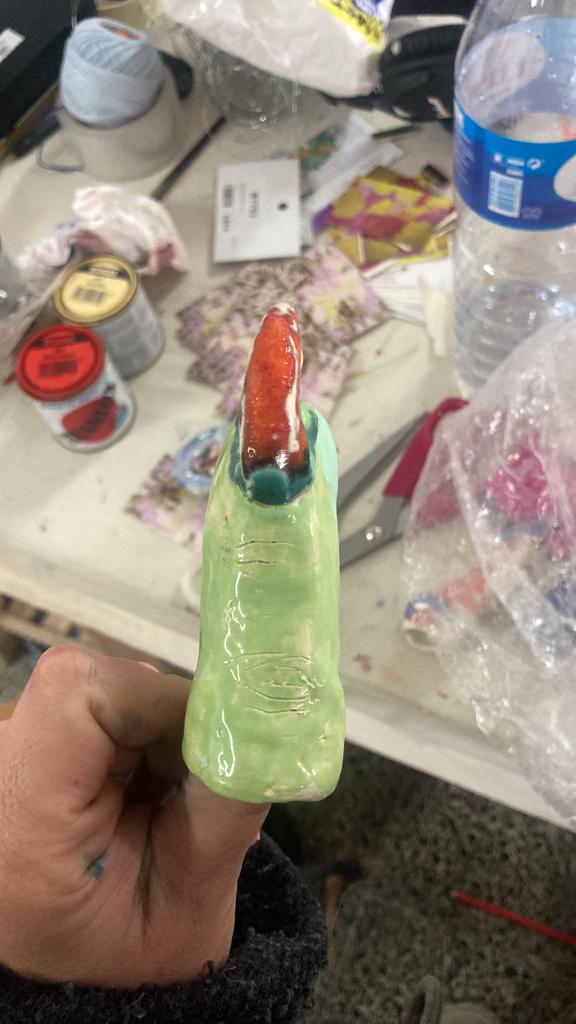
How about the three graces portraying beauty, elegance and mirth? The ceramic feet and papier maché houses you have lately crafted are an ironic and theatrical representation of precious objects such as altars or relics. Can you guide us through the process of chaining these disparate references?
When I did the ceramic letters, I started to do some sculptures of little figures sunbathing or eating ice cream. I loved to hide them around my layered canvas and textile works and play around with them. However, I felt that I wanted to incorporate them into my entire practice and let them have a dialogue. In the first place, these objects were shaped like hands with long nails, quite monstrous and animalistic, becoming props for the poles to hold my fabric works. I started to experiment afterwards - , I separated the fingers from the hands, and I realised these objects actually became more abstract and more precious. They had the perfect balance between beauty and ugliness, dirty and extremely well taken care of neglected and perfect . Like are they perfectly manicured nails or haven't been cut for years., Are they green because of slimy undefinable goo, or is that a fashion statement type of green nail paint? Every little object I then created got its own story, and all are worth worshiping in their own domestic space.

You have manipulated techniques habitually associated with female craftsmanship such as tapestry or ceramic, relating these approaches to the concept of care. Are these choices informed by your personal views on the feminine role? Lisette can you expand on these?
Yes, absolutely, but also definitely not. The funny thing is, when I graduated I considered being a painter and printmaker. I always felt that people just defined me as a textile artist mainly because, apart from the canvas not being on a stretcher, I am female.
The more I got into some hidden hints of feminism in my work, the more I started to embrace the so-called feminine crafts. In the beginning I always realised how my work spoke to women, but they always had to ‘ask their husband’. I started to feel the patriarchy in the art world quite early on. Lately, I have been witnessing a shift in this, that makes me really excited. Most of my work is now owned by female collectors or in shows curated by female curators in woman owned galleries. Continuously fluctuating between abstract and figurative form, I am recently discovering an ion between form where I do find myself repeatedly working with the female figure. Instead of trying to ‘fit in’ the male world, I embrace and focus on the uprising of women. Women are on the rise and I am here for it!
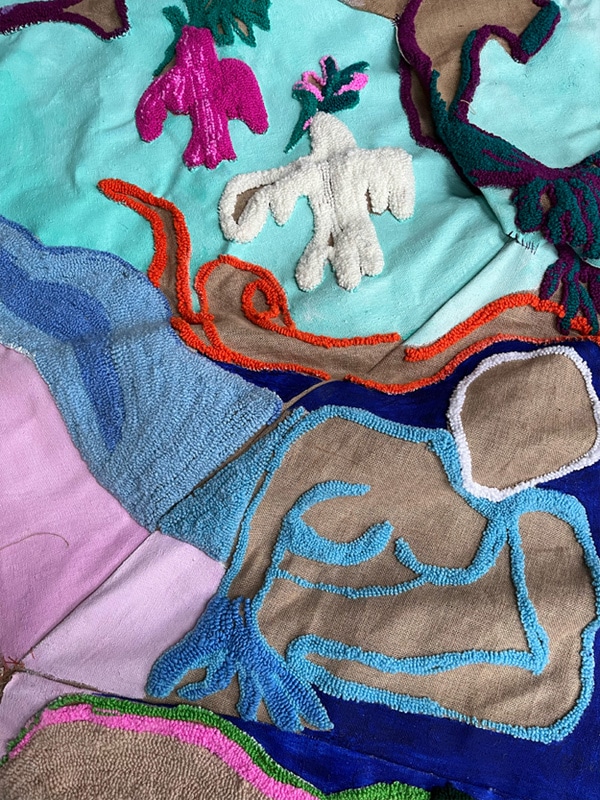
The presence of beach culture imagery has invaded your sculpted figures, taking shape as creatures with blue pointy nails, green skin and deformed features, similar to monsters or mutants, using bikinis, sandals and hair bows. Could you explain this grotesque metamorphosis? What do you think about it, does it reflect a subliminal critique of rigid standards of feminine body image?
I elaborated on this a little bit before, roughly touching the controversy between the thin and subjective line between ugliness and beauty. But not just that, coming from a rather conservative family and being the only girl, I have had quite something to do with their standards of the feminine appearance. Being a so called ‘Tom boy’, which I think is a terribly outdated word, but just to make this point, I was always outside building treehouses in the woods. When I came home from dinner, no matter how dirty my brothers looked like or what they were up to, having dirty nails was ‘not very ladylike’ and I had to scrub them with a brush before I could sit at the table. I have endless examples of where it was okay for my male family members to moisturize their lips with chapstick in winter, but I needed to excuse myself to go to the bathroom to touch up my lipstick, because that’s something considered ‘not done’ in public.
Without boring you with examples, I would say, it does absolutely reflect a critique, but not in an angry way. I use the ridicule of it to ironically point out these etiquettes that have been around for way too long. It’s funny because the longer I think about it, the clearer it is to me that the interest in leisure culture and ‘beach couture’ comes from the same place. At the beach there is so little to distinguish yourself from others. And that exactly is my main focus, rather similarities and building bridges between people, gender, race, cultures, sub cultures because of commonness and similarity.

In the future, you plan to create protective domestics objects of a bigger scale than your current developments. Through this augmentation in size, do you mean to also highlight the critique and social commentary present in your work?
To be honest, I never know where my practice and research is taking me. I have an idea, I start working on it, I discover something small that sparks my curiosity and it becomes a whole new direction that I then must explore. For now I am working on a huge beach umbrella or parasol. The more I get into this, the more it reminds me of those tree houses I used to build as a kid. How and why was that so important to me. First of all, it's clear that I loved exploring and creating, going into nature and on an adventure. But also just to settle again and build a ‘home’, a ‘safe place’, within that undiscovered freedom. There is a lot that hits close to home in this subject matter, that I feel like will definitely take off soon, this is the very small start of it all.
Words by Francisca Portugal

